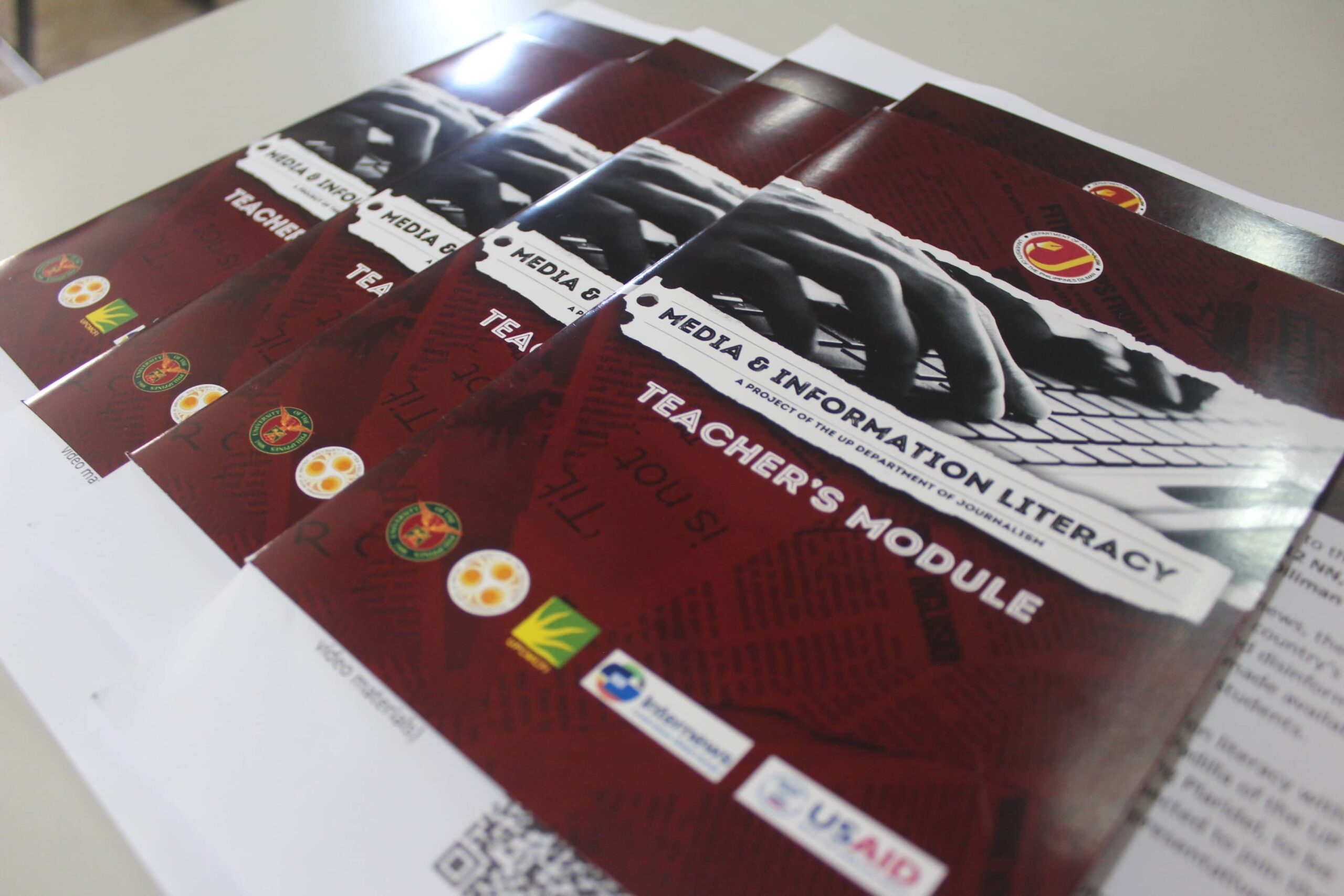In an unprecedented move, journalists from two of the country’s leading news organizations have come together to support the University of the Philippines (UP) Diliman Department of Journalism’s Media and Information Literacy (MIL) project.
The initiative boasts participation from ABS-CBN and GMA reporters, including Karmina Constantino, Jeff Canoy, Zen Hernandez, Atom Araullo, Howie Severino, Mariz Umali, Ivan Mayrina, Connie Sison, and Journalism Department Chair Kara David.
To tackle the widespread issue of information disorder in the Philippines and to overcome existing gaps in MIL instruction, educational videos were created. These videos are designed to combat misinformation and disinformation. Accompanying these videos are comprehensive teacher modules, specifically developed to assist educators in delivering this crucial course to senior high school students.
All outputs are free and accessible to the general public.
“For years and years, ‘pag pinag-uusapan kung paano lalabanan itong fake news, laging sinasabi iyong term na ‘collaboration’. But, it’s all talk. But now, we finally get to see when we stop talking and actually start doing things. And this is that project,” ABS-CBN reporter and MIL Channel lecturer Jeff Canoy said at the project’s launch on October 6.
(For years and years, when discussing how to combat fake news, the term ‘collaboration’ is always mentioned. But it’s all talk. But now, we finally get to see what happens when we stop talking and actually start doing things. And this is that project.)
“This breakthrough collaboration between the two biggest broadcasting firms in the Philippines shows you how important this issue is to all of us,” Internews Philippines Country Director and Chief of Party Peter Mackenzie said.
“All the journalists featured in these videos are passionately committed to advancing media and information literacy in the Philippines. The future of good journalism and a healthy Philippine society depends on it,” Mackenzie continued.
The MIL project was conceived in response to the knowledge gap among educators tasked with teaching MIL classes. According to David, many teachers are not adequately equipped to instruct students on the intricacies of disinformation and the critical need for fact-checking.
“The current media literacy curriculum is too heavy and it’s complicated. It lacks focus and tries to squeeze in a lot of information in just one semester,” David said.
“Maganda ang layunin pero masyadong marami at kulang sa focus. And, it is not well-adapted to the current Philippine setting. Admittedly, sabi ng mga nagtuturo ng media and information literacy ngayon, most teachers are not well-equipped to handle the MIL classes,” she added.
(While well-intentioned, it is not properly tailored to the Philippine context. Teachers currently instructing media and information literacy acknowledge that most are inadequately prepared to effectively teach these classes.)
David highlighted the team’s strategic approach in adapting to the media consumption patterns of Filipinos, especially the younger generation. By leveraging digital platforms, they sought to produce content that aligns with the current trends of media engagement.
“Actually, no’ng ginawa namin itong project na ito, ang original target namin ay iyong mga Gen Z. Kayâ, pinasulat namin iyong script sa aming mga estudyante. Para iyong language ay language ng Gen Z. Tapos iyong content, gáling sa aming mga Journalism teachers,” she told DZUP.
(During the inception of this initiative, we aimed to resonate with the Gen Z demographic. To achieve this, we entrusted the scriptwriting to our students, while the substance of the content came from our Journalism teachers.)
UP College of Mass Communication Dean Fernando Paragas echoed David’s sentiments.
“The videos we are launching are an important first step for us in the College to engage our publics directly on social media in the shape and form they have grown to like while still upholding our standards for substance and rigor. That we are joined by the biggest names in media today hopefully lends credence and virality to the videos,” Paragas said.
UP students Anj Guillermo and Stephen Daniel Busico, who contributed as scriptwriters for the project, are confident that the production style of the episodes will effectively enhance MIL awareness among their peers.
“Iyong pagsusulat namin, kailangan hindi malalim. Dapat iyong maiintindihan kahit sinong mga estudyante, kahit hindi senior high. Kailangan nakalapat iyong language namin,” Guillermo told DZUP.
(Our writing needs to be simple, it should be understandable by any student, not just those in senior high. Our language must be relatable and easy to grasp.)
“Ang maganda dito, ginamit iyong vlogging style. Kasi iyong broadcast news, minsan na lang din pinapanood ng kabataan. Mas nagfo-focus na ang kabataan ngayon sa social media. Mas effective way [ito] para mapag-aralan ng kabataan iyong fake news, fact-checking and such,” Busico told DZUP.
(What’s good about this is the use of the vlogging style. Because broadcast news is rarely watched by the youth nowadays. Young people are now more focused on social media. It’s a more effective way for them to learn about fake news, fact-checking, and such.)
One of the Department’s partners in this endeavor, the United States Agency for International Development (USAID), recognized the contribution of media students to the project.
“That’s icing on the cake. It’s gratifying to see future media practitioners be involved in something so worthy and so relevant to our times,” USAID Gerardo Porta Senior Democracy and Governance Program Manager said.
Porta also noted the importance of MIL as a crucial tool in the multifaceted battle against disinformation.
“Media and information literacy, to be sure, is not a panacea. There is no silver bullet. It is one component of our arsenal of tools to combat disinformation, which includes platform accountability,” he said.
“There’s support for platform accountability, investigative journalism. There’s support for fact-checking, amongst many, in terms of initiatives to combat disinformation,” he added.
“To me, MIL is your inoculation against the infodemic. So, it is vital.”
Scholars and experts have observed the impact of information disorder, such as misinformation and disinformation, in the Philippines.
“The Philippines, unfortunately, has the dubious distinction of being one of the first countries that observers around the world saw as a playground for purveyors of disinformation. Filipinos are practically drinking from a firehose of disinformation everyday,” Porta said.
“There are few countries in the world that have experienced such a wave of online disinformation and influence operations like the one that has broken over the Philippines in recent years,” Mackenzie said.
“As a result, media and information literacy has become a crucial need, especially for young people who are just learning to navigate our confusing information ecosystem and to sort through the information disorder,” he added.
Editor’s Note: The videos are publicly available and can be viewed by visiting the UP Department of Journalism’s YouTube channel at https://www.youtube.com/@UPJournDept.

